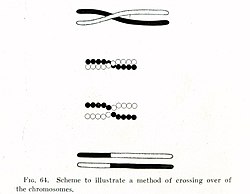Thomas Hunt Morgan
Thomas Hunt Morgan (25 September 1866 – 4 December 1945) was an American geneticist and embryologist. Morgan took his PhD at Johns Hopkins University in 1890, and researched embryology while at Bryn Mawr College.
Thomas Hunt Morgan | |
|---|---|
 Johns Hopkins yearbook of 1891 | |
| Born | September 25, 1866 |
| Died | December 4, 1945 (aged 79) |
| Nationality | United States |
| Alma mater | University of Kentucky Johns Hopkins University |
| Known for | Drosophila melanogaster |
| Awards | Nobel Prize in Physiology or Medicine in 1933 |
| Scientific career | |
| Fields | geneticist embryologist |
| Institutions | Bryn Mawr College Columbia University California Institute of Technology |
| Doctoral students | Alfred Sturtevant; Calvin Bridges George Beadle; Alexander Weinstein Edgar Altenburg; Hermann Muller |
After the rediscovery of Mendelian inheritance in 1900, Morgan switched his research to the fruit fly Drosophila melanogaster. In 1904, E.B. Wilson invited Morgan to join him at Columbia University. This move freed Morgan to focus fully on experimental work.[1] In his famous Fly Room at Columbia, Morgan was able to show that genes are carried on chromosomes and are the mechanical basis of heredity. These discoveries formed the basis of the modern science of genetics.
Morgan moved to California in 1928 to head the Division of Biology at the California Institute of Technology (CalTech). Research was focused on genetics and evolution; experimental embryology; physiology; biophysics and biochemistry.
He was given the Nobel Prize in Physiology or Medicine in 1933. It was the first one given for genetics, for his discoveries concerning the role played by the chromosome in heredity.[2] The prize was not shared with the lab's main researcher, Alfred Sturtevant, a decision of the Nobel Committee which was certainly controversial.[3]
Morgan's early work with Drosophila was on the associations known as 'coupling' and 'repulsion', discovered by English workers in 1909 and 1910 using the Sweet Pea. These were, in reality, the same phenomenon, which was later called linkage. Morgan's first papers dealt with the demonstration of sex linkage of the gene for white eyes in the fly, the male fly being heterogametic (XY).
During his distinguished career, Morgan wrote 22 books and 370 scientific papers,[4] and, as a result of his work, Drosophila became the main 'model organism' in genetics. The Division of Biology he started at the California Institute of Technology produced seven Nobel Prize winners.
Thomas Hunt Morgan Media
In a typical Drosophila genetics experiment, male and female flies with known phenotypes are put in a jar to mate; females must be virgins. Eggs are laid in porridge which the larvae feed on; when the life cycle is complete, the progeny are scored for the inheritance of the trait of interest.
Morgan's illustration of crossing over, from his 1916 A Critique of the Theory of Evolution
References
- ↑ Allen, Garland E. 1978. Thomas Hunt Morgan: the man and his science. Princeton University Press, pp 68-70. ISBN 0-691-08200-6
- ↑ "The Nobel Prize in Physiology or Medicine 1933".
- ↑ Kohler, Robert E. 1994. Lords of the fly: Drosophila genetics and the experimental life. Chicago.
- ↑ Fisher, Ronald A. and G.R. de Beer (1947). "Bibliography of Thomas Hunt Morgan". Obituary Notices of Fellows of the Royal Society. 5 (15): 455–466. JSTOR 769094.




